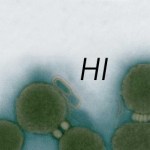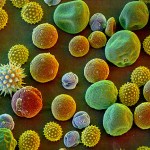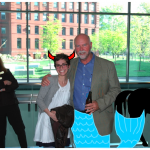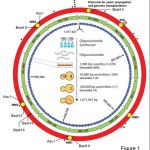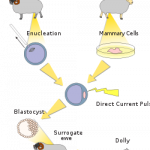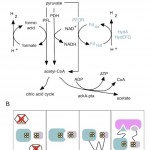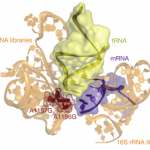DNA
Silk is an amazing biomaterial, cultivated and prized for more than 5,000 years. The silk threads that we weave into our shiny fabrics are actually enormous protein crystals produced by insects. This industrial silk that you can buy at the mall is made by silkworms, which use the silk to form the cocoon that protects them as they transform into moths. Many other species of insect also produce silk proteins to protect themselves or their eggs, get around, or catch their prey, but none in such enormous quantity in such easy to harvest packages as the silkworm. Silks from different species are…
What do these three quotations have in common? Hint: it lives in a petri dish.
"To live, to err, to fall, to triumph, and to recreate life out of life." -- James Joyce
"What I cannot build, I cannot understand." -- Richard Feynman
"See things not as they are, but as they might be." -- from American Prometheus, a biography of the nuclear physicist Robert Oppenheimer
Although James Joyce could never have imagined it, his words -- and those of Feynman and Oppenheimer, too -- are no longer relegated to library stacks, but instead live on inside an unlikely host: the world's first synthetic…
Biosafety has been on everyone's mind this week after the announcement of the J. Craig Venter Institute's successful transplantation of a synthetic genome. What horrible pathogen will future bioengineers be able to design? What unforeseeable environmental catastrophe will befall us upon the release of genetically engineered bacteria? These are hugely important questions as research in synthetic biology moves forward, being discussed in congressional hearings and as an integral part of every new synthetic biology design.
As the major proposed goal of a great deal of synthetic biology research…
I had the pleasure of chatting with John Hawks about the two big science news stories of the past few months, the synthetic genome and the Neandertal genome, for Science Saturday at bloggingheads.tv.
John is a professor of anthropology at the University of Wisconsin who studies population genetics of ancient humans, as well as a terrific teacher. I learned a lot of really fascinating things about how people study fossils and trace human evolution and it was interesting to find some connections between the two stories! As he mentions on his blog, we didn't once mention synthetic Neandertals…
There is an interesting and very thoughtful piece by Craig Venter and Daniel Gibson in today's Wall Street Journal going through what their breakthrough is and what it isn't, where they see the project going in the future, and why public discussion is important:
[Previous genetic engineers] did not create life in a test tube, nor did we create life from scratch. We transformed existing life into new life. We also did not design and build a new chromosome from nothing. Rather, using only digitized information, we synthesized a modified version of the naturally occurring Mycoplasma mycoides…
A recent New York Times article tells us that what many people call food allergies are actually simple intolerances, and that allergies are being dangerously overdiagnosed. What is a true food allergy, and what can be done to fix them besides banning peanuts from schools and avoiding foods that make us itchy?
Allergies are caused by an inappropriate immune response to common things in the environment. Usually the offending allergen is a protein that comes from plants or animals like pollen or dander. Instead of the immune system recognizing that these proteins are harmless, it instead…
The reaction to the Venter Institute's synthetic genome transplantation has been decidedly mixed. Is this the beginning of something new and wonderful, the ability to really design organisms from scratch? Is it something more sinister, the beginning of a dark era where techno-corporate (or terrorist) interests can design something that will destroy the environment in catastrophic ways? Is it just a technical advance or a conceptual breakthrough? A philosophical revolution? Is it a Big Deal or big whoop? Synthetic biology has never been just one thing and still has many different goals, with a…
The J. Craig Venter Institute has just announced the creation of the first bacterial cell controlled by a genome that is entirely chemically synthesized (PDF). The group has been working towards this goal for several years now, first working out how to synthesize and assemble such large pieces of DNA and how to transplant a genome from one organism to another. This result puts it all together, a synthetic version of the genome of the bacterium Mycoplasma mycoides and transplantation into a Mycoplasma capricolum cell. This synthetic cell is almost identical to a natural M. mycoides, but also…
My semester in MIT's course on Documenting Science Through Video and New Media has drawn to a close. I've had a wonderful time and learned a lot about how films and science are constructed by different people in different times for different reasons. Most of all I've learned about how challenging it can be to put together an interesting narrative and present a point of view while at the same time ensuring that the science being explained is honest and clear to everyone. I've recently gotten the chance to watch two great recent science documentaries outside of class, Naturally Obsessed and…
The skeletons of female (larger, background) and male (smaller, foreground) Dinornis robustus, with a pigeon skeleton for comparison. From Allentoft et al 2010.
A little more than 700 years ago, multiple species of the gigantic, flightless birds called moas were still running around New Zealand. They ranged over almost the entirety of the North and South Islands, from the coast to the mountain forests, but when the Maori people arrived in the late 13th century the birds were quickly driven to extinction. Within a few hundred years they were entirely wiped out (along with the immense Haast…
This week we delve into the genes of the mystery organism. Here's a short snippet of DNA:
ATGTCGCGTATCATGGAAAAGGAAAACATCACCGAAAATCTGGAAAAGATTTCCATCAAGAATGCTCGTA
5 points for the first person to pick the genus and species, and 5 points to the first person who can explain why this particular gene was targeted for study.
I'll post the answer tomorrow. Since we've reached the end of the month, I'll tally all the points from the preceding mysteries and announce the March/April mystery winner, who is entitled to either 1) any 8 x 10 print from my photo galleries, or 2) a guest blog slot on any (…
New in vitro fertilization technology is making it possible for someone to have two moms--one that provides the genome in the nucleus of the cell, and one that provides the rest of the egg cell, including the mitochondria. Since all mitochondria are passed down from the mother in the egg (sperm are just too small to provide anything but the father's genetic material to the fertilized embryo), transplanting the nucleus from a fertilized embryo to an egg from a different woman can bypass the transmission of any mitochondrial diseases that the mother carries. Because mitochondria have their own…
An interesting paper in BioEssays last month looks at the potential future of xenobiology, totally orthologous biological systems made out of synthetic nucleotide and amino acid bases, new cells that use XNA instead of DNA. The author, Markus Schmidt, argues that while the design of such systems current poses a difficult technological challenge to researchers in synthetic biology, that xenobiological systems will enable a "genetic firewall" between natural and designed organisms, creating a built-in measure of biosafety.
This is something I've argued for before, in reference to creating new…
Last week's issue of Nature focused on the progress (or lack thereof) in genomics and related fields since the Human Genome Project (HGP) was completed ten years ago. In many ways, the era of genomics has yet to fulfill many of the promises made twenty years ago, but the investment in science and technology has at the same time made a valuable impact on many fields in basic science. Understanding this recent history of the genomics bubble is crucial to how we approach current science and technology investments in areas such as personal genomics and importantly, synthetic biology.
In a…
Another Hydrocalypse Industries original production, the Beard-ome presents imaginary work on the genomics of the beard. What's lying beneath your beard?
Even extinction and the passing of millennia are no barriers to clever geneticists. In the past few years, scientists have managed to sequence the complete genome of a prehistoric human and produced "first drafts" of the mammoth and Neanderthal genomes. More controversially, some groups have even recovered DNA from dinosaurs. Now, a variety of extinct birds join the ancient DNA club including the largest that ever lived - Aepyornis, the elephant bird.
In a first for palaeontology, Charlotte Oskam from Murdoch University, Perth, extracted DNA from 18 fossil eggshells, either directly…
My paper, "Insulation of a synthetic hydrogen metabolism circuit in bacteria" just came out in the Journal of Biological Engineering! And it's open access!
We designed a metabolic circuit in bacteria that produces hydrogen (a potentially useful fuel) from natural precursors in the cell. The proteins in our synthetic pathway work to make hydrogen by transferring high-energy electrons from pyruvate, a common metabolite, to protons that are freely floating in the watery cytoplasm. The electrons transfer between the proteins through quantum-mechanical tunneling, which makes hydrogenases and…
tags: handheld thermal cycler, LavaAmp, PCR, Polymerase Chain Reaction, DNA, molecular biology, Unreasonable Insitute, DIY, technology, Guido Núñez-Mujica, streaming video
Millions of people in the Global South suffer from neglected diseases, many of which could be treated, even cured, if they were detected early enough. But reliable, low cost diagnosis hasn't been available, as drug companies have no incentive to invest in the diseases of the poor. New pandemics can go undetected until they have spread out of control, like HIV, and treatable ailments can cripple impoverished communities…
Some of the responses to my post about synthetically expanding the genetic code have highlighted some of the weaknesses in my argument about the safety of using a different genetic code. Namely, that "life finds a way", that we can't really ever know for sure what will happen when we release a synthetic organism in the wild, or how natural selection will act on them. The science fiction scenarios where engineered organisms escape, break out of the designed restrictions on their growth and take over in new and terrifying ways are compelling, frightening, and instructive for thinking about…
Almost every living thing shares an identical genetic code, with three nucleic acids in an RNA sequence coding for a single amino acid in the translated protein sequence. While there are 64 three-letter RNA sequences, there are only 20 amino acids and degeneracy in the code allows some amino acids to be coded by multiple codons. Chemists and synthetic biologists in the past few years have been working to expand this genetic code, with unnatural nucleotides that can be incorporated into DNA and RNA sequences and unnatural amino acids that can expand the chemical functionality of proteins.…

